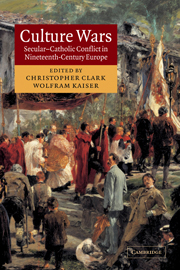Book contents
- Frontmatter
- Contents
- List of illustrations
- List of contributors
- Introduction: The European culture wars
- 1 The New Catholicism and the European culture wars
- 2 ‘Clericalism – that is our enemy!’: European anticlericalism and the culture wars
- 3 ‘Priest hits girl’: on the front line in the ‘war of the two Frances’
- 4 The battle for monasteries, cemeteries and schools: Belgium
- 5 Contested rituals and the battle for public space: the Netherlands
- 6 Nonconformity, clericalism and ‘Englishness’: the United Kingdom
- 7 The assault on the city of the Levites: Spain
- 8 Roma o morte: culture wars in Italy
- 9 Enemies at the gate: the Moabit Klostersturm and the Kulturkampf: Germany
- 10 Village quarrels and national controversies: Switzerland
- 11 The Counter-Reformation's last stand: Austria
- 12 The uncivil origins of civil marriage: Hungary
- Annotated bibliography
- Index
8 - Roma o morte: culture wars in Italy
Published online by Cambridge University Press: 23 July 2009
- Frontmatter
- Contents
- List of illustrations
- List of contributors
- Introduction: The European culture wars
- 1 The New Catholicism and the European culture wars
- 2 ‘Clericalism – that is our enemy!’: European anticlericalism and the culture wars
- 3 ‘Priest hits girl’: on the front line in the ‘war of the two Frances’
- 4 The battle for monasteries, cemeteries and schools: Belgium
- 5 Contested rituals and the battle for public space: the Netherlands
- 6 Nonconformity, clericalism and ‘Englishness’: the United Kingdom
- 7 The assault on the city of the Levites: Spain
- 8 Roma o morte: culture wars in Italy
- 9 Enemies at the gate: the Moabit Klostersturm and the Kulturkampf: Germany
- 10 Village quarrels and national controversies: Switzerland
- 11 The Counter-Reformation's last stand: Austria
- 12 The uncivil origins of civil marriage: Hungary
- Annotated bibliography
- Index
Summary
Like most of the rest of Europe, nineteenth-century Italy passed through a phase of heightened political and cultural conflict over the place of religious allegiances in a modern polity. Yet the Italian experience of culture war was also in some respects quite distinctive. In Italian parlance, the word ‘Kulturkampf’ was used untranslated as a foreign expression that referred specifically to German conditions. The Italian culture war was less consistently organised at state-bureaucratic level than in Germany and the issues over which it was fought were in some respects quite different. By contrast with France, there was no strong republican-laïciste tradition. In order to convey a sense of what was distinctive about the Italian culture war, we should begin with an overview of the most important flashpoints of the conflict.
FLASHPOINTS
The presence of the papacy and of the ‘Roman question’ made the church–state relationship in Italy unique. But it is important to note that the history of ‘the pope and Italy’ had not always been one of unremitting antagonism. The unification of the country and the promotion of a national identity were not always seen as inimical to the interests of the papacy. Between 1815 and 1848, there were strong neo-Guelph tendencies within the Italian national movement. In 1843, writing from his exile in Brussels, Vincenzo Gioberti argued that Italy owed its unique historical position in the world to the outstanding imperial achievement of ancient Rome, and its claim to contemporary pre-eminence to the presence of the Holy See.
- Type
- Chapter
- Information
- Culture WarsSecular-Catholic Conflict in Nineteenth-Century Europe, pp. 202 - 226Publisher: Cambridge University PressPrint publication year: 2003
- 6
- Cited by



